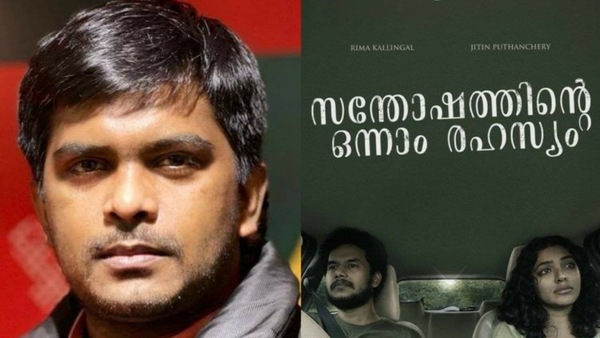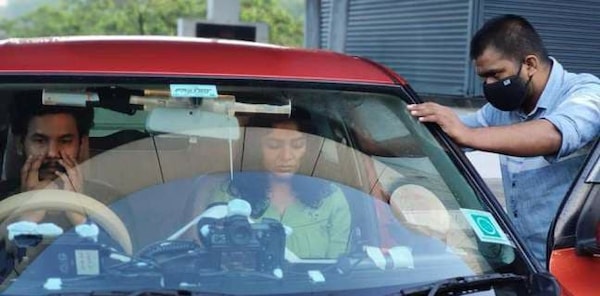Exclusive! Don Palathara: ‘I don’t intend to preach, I want to portray the complexities of people’
Director Don Palathara talks to OTTplay about his latest movie Santhoshathinte Onnam Rahasyam

Last Updated: 07.21 PM, Jul 26, 2021
Don Palathara’s single shot movie, Santhoshathinte Onnam Rahasyam, is a landmark in the history of Malayalam cinema. It offers a new experience to the viewers, as the 85-minute project, which revolves around the life of a couple, has been filmed in one continuous shot, without a break. The relationship drama involves uninhibited expressions, conflicts and raw emotions between two people, played by Rima Kallingal and Jitin Puthanchery. The director talks to OTTplay about his unique experiment and the various preparations involved while making this ‘Joyful mystery’.
An 85-minute movie, filmed in a single shot, is a new experience for Malayali audiences. Malik, which was released recently, had a long shot of 12-minute duration, which was much-raved about. What do you think about the usage of single shots in movies?
The usage of single shots always offers a different experience to viewers and meaning to the film. With regard to the single shot in the film, I’d like to leave it for the audience's interpretation rather than me explaining it. If I do, they will see it only through my perspective. I wanted to showcase how closed our lives have become, restricted to a limited space, since the beginning of the pandemic.
Can you delineate on the entire shooting experience, including rehearsals and other preparations?
We had a well-prepared script in the first place. We took almost a month’s time for the preparations including the workshops. Rima and Jitin made things easier for me as they could learn the script and adapt to their respective characters easily. Since I couldn't always be there with the actors and cinematographer, I had to make sure that even if there is a slight change in one person’s dialogue, the other one has to follow up. I believe both the actors have done a great job; they shared a wonderful chemistry. On the technical side, too, there was a perfect team, including our cameraman Saji Babu, who coordinated with the team excellently.
What were Rima’s and Jitin’s contributions to the script?
Amid the practice sessions, I had given them situations to enact at their own pace and surprisingly this worked out amazingly as they were able to put their versions to the characters. Later, I added their inputs to the script; it was easy for them to come up with natural performances.
What do you think about political correctness in movies? Have you ever felt it as a burden while writing the script?
I have been anticipating the film being viewed through the lens of political correctness while working on the script as it is something which is talked about a lot today. But I think making a movie only to preach about something costs us the loss of unique character traits. I don’t believe that cinema is a medium to preach certain things; it’s not the final word. For me, films are a way of understanding human beings deeper by portraying different elements of them. Also, political correctness is dynamic, it changes with time. What was politically correct 10 years ago would seem unconvincing after 10 years. So, art should not be limited, it should be viewed in a wider perspective.
Santhoshathinte Onnam Rahasyam seems to be addressing different issues like live-in culture, PMS, accidental pregnancy, and so on. What does the film really intend to convey in general?
I don’t intend to give any message through my movie. When I approached the plot, I wanted the story of a couple and intended to bring out their conflicts through dramatic art. In our society, pregnancy is something that would shake a live-in couple to the core. So, I chose to showcase the varied emotions related to it. Also, I believe that all relationships are not perfect; I wanted to portray it in a realistic manner with all the human flaws.

What was the feedback after the film was screened at the International Film Festival of Kerala?
Many viewers reacted positively and appreciated the different aspects of the movie. But the reaction was mixed; there were unexpected responses, too. People were seen cheering up for dialogues in instances where both the characters abuse each other. Rather than seeing them as characters, they were cheering up because Rima was getting abused. So, I believe that the audience's reactions cannot not be predicted or trusted.
Social media matters a lot today. What do you think about reviews and criticisms from social media?
I think that the opinions of people on social media are changing so fast. Many are realising that the filtered political readings on movies could easily gain popularity. While reading reviews, I was happy to see that they have approached it in a positive way. Also, OTTs have made the movie world more accessible to the audience and they seem to watch movies ranging from old classics to latest ones. So, the audience’s intelligence does matter and I look towards their feedback in a hopeful manner.
What challenges do OTTs put before you?
Even though OTTs have opened up our digital world, it still hasn't catered to the taste of different kinds of audience. There are more than 150 OTT platforms and many are still confused about what to watch from where. I hope this will evolve with time. Talking about the challenges, it doesn’t pertain only to OTTs, especially while living in a capitalistic society, it affects the cinema world, too. Not only OTT releases, even for theatre releases, if a movie with big budget and star value is up for release, the comparatively smaller ones will be sidelined. Also, piracy is a challenge now, and many still think movies are unrealistic and unworthy for their money. They often don’t realise the efforts of the cast and crew, but COVID-19 has brought a change there, too. Online world has become easier for people, OTT subscriptions have increased, and the way of living is changing, too.
Your previous movies like 1956 Central Travancore and Shavam were in monochrome. Why did you choose it over colouring?
I’m against over usage of colours on screen just for the heck of it, and I want to do movies in a way I would like to watch them. I like to stick to a specific colour palette mostly in my movies. Also, it is partially due to my personal view towards the outer world. I don’t think our lives would always be cheerful and colourful. There are different dimensions which cannot be approached optimistically. So, this theory would also be reflected in my works.
Subscribe to our newsletter for top content, delivered fast.

